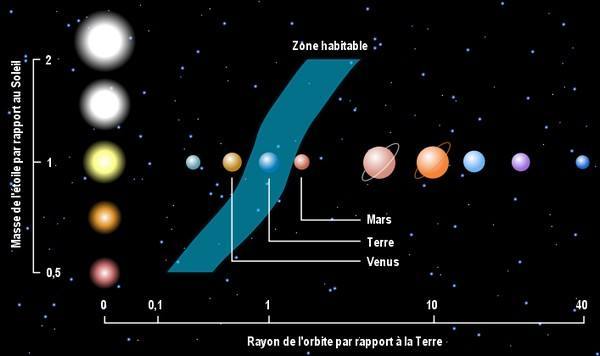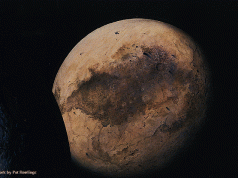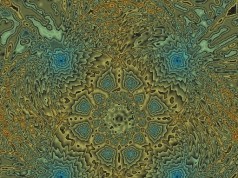Abstract: The Earth is already all too close from being getting all too hot, from its astronomical position at the interior edge of the Sun’s Habitable Zone.
The Greeks viewed Gaia, the Earth, as the Mother Goddess from whom all other gods sprang. Yet, discoveries they made later showed that this metaphysics was misleading. In truth, habitable planets, far from being all powerful, are confined to narrow zones around their stars (and these zones move, and are under continual threat, as I describe below):
Vertically the masses, going up, the unit being the mass of the sun; as stars gets bigger, they get hotter, thus they change color, covering the entire black-body spectrum, from brown dwarves to blinding ultra violet hot “Blue Stragglers”.
Horizontally, the distance from the star; the graph gives only a rough idea of the notion of Habitable Zone; in truth the whole point of this essay is that Earth is at the edge of Sol’s Habitable Zone, within 1% of boiling; Habitable Zones narrow as the stars get smaller, and get much larger, far out, around bigger stars.
The life of Earth on the edge has got more dicey in the last 400 million years. Thus the risk of hyper warming is greater than in the Carboniferous Era. By pumping into the atmosphere the equivalent of 100 million tons of CO2, every single day, we are, literally, playing with fire. (A first counter-measure would be to outlaw, through regulations, those gases that warm up the air a lot, and are not indispensable; for example leaks in the pipelines of the USA allow 4% of the CH4 to escape!)
The two close calls by large space rocks were a reminder that this is a serious, not particularly friendly universe. Something to meditate carefully.
Those who play apprentice sorcerers with the climate and planetary ecology should pay attention.
For reasons having to do with the periodic table, the frequency of elements and the chemical characteristics of carbon, namely its ability to form many liaisons, it seems likely that life in the universe will have to resemble life on Earth. That is being water, carbon and oxygen based. (Believing that life does not have to be carbon-centric may sound cute, but it’s unreal.)
Thus the habitable zone is the zone around a star where it is neither to hot, nor too cold, and a planet can support water.
Not all stars can have an habitable zone: the greater the mass of a star, the more fiercely it burns. A star with five times the mass of the sun will typically have 625 times the luminosity of the sun.
Why? In small stars, the part of the core hot and dense enough to sustain thermonuclear fusion is relatively small. In large stars, it becomes enormous, and embraces much more of the thermonuclear fuel tank.

Thus, the larger the mass, the shorter the lifespan of the entire system orbiting the star. A star with 60 solar masses will shine only 3 million years before running out of hydrogen. At that point it will run hotter and hotter as it burns heavier elements until it explodes as a super nova. A star of five solar masses will live longer, but still only 100 million years or so. Long enough to make it a tourist destination, not long enough to evolve life (all the more as the habitable zone will migrate out fast, as the stellar furnace gets hotter, fast).
Even a star with only 50% larger mass than the Sun will live only three billion years. On Earth, after that duration, the first oxygen making organisms were appearing, and the atmosphere was going to change completely, from reducing to oxidizing. That would bring the “Snowball Earth” episodes, 600 million years ago, or so, when most of the planet froze, before enough CO2 could be generated to reach the appropriate greenhouse effect.
Clearly, for evolving advanced life, more than a billion years is needed. Thus planets with indigenous life will be restricted to red and yellow dwarves (the sun is one of the latter, with an estimated lifespan of ten billion years before turning ephemerally into a red giant).
The 2012 sci-fi (silly) movie “Battleship” has it right on that point: most of the habitability is found cuddling next to red dwarf stars, so that aliens would be blinded by our sunlight is likely. This also means that life out there has a good probability to have evolved in what, for us, would be rather dim circumstances. Indeed most stars are red dwarves and those are the longest living stars, easily going on for 15 billion years (they use their thermonuclear fuel conservatively).
Some red dwarves could have evolved life, in our Milky Way galaxy, when our sun, a mighty yellow dwarf, did not exist yet. Such stars, with their habitable planets, could still be around.
Being in the habitable zone is necessary for life, but it’s not sufficient.
For example, any planet orbiting too close to its star will lock its orbital rotation and its diurnal rotation (as the Moon has with the Earth). Thus the planet will have one side too hot for life, and the other too cold.
That means that when red dwarves become too small, their habitable zones, get too close, and would-be habitable planet lock down. (Venus, although 100 million kilometers from the Sun is nearly locked: it rotate on itself slower than it does around the Sun.)
The Earth is totally exceptional. She is endowed with a huge satellite that stabilizes her inclination on the orbital plane (Mars’ inclination on the elliptic varies wildly, causing wildly fluctuating super-seasons). This resulting, constant and mild inclination allows the poles to not get too cold, and the tropics, not too warm: it spreads the goodness of sunlight around.
Earth is also a mighty nuclear reactor, providing with the shield of a powerful magnetosphere (Venus does not have any, so its upper atmosphere is scorched by the solar wind), and plate tectonic (allowing for a complex recycling mechanism involving CO2 and long term climate stability).
The present, sort of official, habitability zone theory is 20 years old. It showed that Earth was within 5% of receiving too much warmth from her star. What has been found by the latest study is even more disturbing: Earth is within 1%, 1.5 million kilometers of inhabitability (5 times the Earth-Moon distance).
Earth is, astronomically, at risk of getting too hot, and of suffering a run-away greenhouse, as Venus did.
Long ago, Venus may have been in the habitable zone. However, general main sequence star theory, and observation, show that the Sun has warmed up. Its power output has increased by at least 25% since it got started. So the habitable zone in the Solar System has been slowly moving outward.
Why did the Earth cool over the last 100 million years, if the sun is slowly warming up? It probably has to do with non linear effects related to the geometry of the continents: the continents migrated north, and shallow tropical seas disappeared. The migration of land towards the north augmented the albedo of the Earth (as land stays frozen in summer more easily than sea, ice and snow keep reflecting more sunlight back to space, even then; that’s the core of the two centuries old glaciation theory).
So, as Earth should have warmed up, by a miracle, a sun shade, the glaciated North, was put in place, just in time!
Not all the coolness is due to ice and snow. Earth, before very recent human interference, had long been endowed with a cool climate. It seems that clouds make the difference (the effects clouds bring are too complex to be taken into account in computer programs of habitability at this point).
It’s a double edged sword. Water vapor may bring more clouds, but it is also a mighty greenhouse gas.
Still the point remains that all the objective data show that, our planet is not far, astronomically speaking, from a runaway greenhouse. By keeping on pumping a witches’ brew of greenhouse warming gases in the atmosphere, we are, literally playing with fire. Every day we add nearly 100 million tons, in CO2 alone, in our apparent urge to mimic Venus.
Pumping 450 million years of carbon into the air all of a sudden is not smart: Earth has had plate tectonics from the start, so much of this carbon was sequestered. Now we are freeing huge quantities of it. and in a geological, and biological, snap.
All other things being equal, the Earth is closer to inhabitability through warming than it was 400 million years ago (when the CO2 was very high). Having the same CO2 in the air as in the Carboniferous Era would result in a warmer planet.
To make things worse, there are no plausible technological fixes to too much CO2 in the atmosphere (with existing science and technology; and contrarily to disinformation from the fossil carbon burning fanatics).
In between the high- and low-mass stars lie stars similar to our own Sun. They make up about 15% percent of the stars in the galaxy. Such stars have reasonably-broad Habitable Zones, do not suffer from hard UV irradiation, have lifetimes of the order of 10 billion years. They are the best candidates for harboring planets with indigenous life.
Intriguingly, the three stars of the Alpha Centauri system may harbor life. The system is made of two main yellow dwarves, one slightly bigger, one slightly smaller than the sun. They come as close to each other as Saturn is from the Sun (not close enough to affect each other Habitable Zones directly).
A planet was just detected, grazing the .9 solar mass Alpha Centauri B. (We have the means to find out if the system supports life, but NASA and the Congress of the USA, shut down the projects, in an apparent fit of obscurantist anti-science rage; one of them called the Terrestrial Planet Finder; Alpha Centauri would be reachable with nuclear propulsion.)
The stability of orbits (hence of the Habitable Zones) in the Alpha Centauri system has been debated. Many a stellar system has been found where giant planets have progressively swept the entire system. And we are always one giant comet away from extinction. That could happen in 6 months. And we don’t know, because we are apparently not interested to find out. (Although the mightiest nuke could solve that problem, that would require some preparations.)
Life exists in the cosmos, everywhere, but it’s fragile. Everywhere. Including on so far invincible fortress Earth. Invincible, but still so fragile.
3,000 years after the Greeks elaborated their mythology, we find out that, contrarily to what they guessed, Earth is far from the mother of all what is divine. There are greater powers out there. The worst of them being, potentially, ourselves.
As a star goes up the main sequence, its Habitability Zone moves out. So we should be careful to think we can reconstitute the conditions of the Carboniferous Era, by pumping as much CO2 in the air as there was then, and prosper.
Everything indicates that we will punch straight trough.
Patrice Ayme






